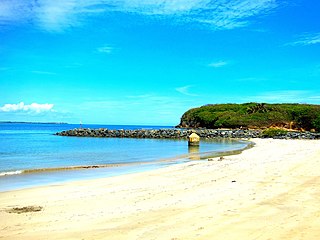Related Research Articles

San Juan is the capital city and most populous municipality in the Commonwealth of Puerto Rico, an unincorporated territory of the United States. As of the 2020 census, it is the 57th-largest city under the jurisdiction of the United States, with a population of 342,259. San Juan was founded by Spanish colonists in 1521, who called it Ciudad de Puerto Rico.

Bayamón is a city, municipality of Puerto Rico and suburb of San Juan located in the northern coastal valley, north of Aguas Buenas and Comerío; south of Toa Baja and Cataño; west of Guaynabo; and east of Toa Alta and Naranjito. Bayamón is spread over 11 barrios and Bayamón Pueblo. It is part of the San Juan-Caguas-Guaynabo Metropolitan Statistical Area and the second most populous municipality in both the metropolitan area and Puerto Rico.

El Nuevo Día is the newspaper with the largest circulation in Puerto Rico. It is considered mainstream and the territory's newspaper of record. It was founded in 1909 in Ponce, Puerto Rico, and today it is a subsidiary of GFR Media. Its headquarters are in Guaynabo, Puerto Rico.

Toa Baja is a town and municipality of Puerto Rico located in the northern coast, north of Toa Alta and Bayamón; east of Dorado; and west of Cataño. Toa Baja is spread over five barrios, including Toa Baja Pueblo. Toa Baja is part of the San Juan-Caguas-Guaynabo Metropolitan Statistical Area. Toa Baja is located fifteen minutes by car from San Juan and two hours from Ponce.

Puerto Rican literature is the body of literature produced by writers of Puerto Rican descent. It evolved from the art of oral storytelling. Written works by the indigenous inhabitants of Puerto Rico were originally prohibited and repressed by the Spanish colonial government.

An estancia or estância is a large, private plot of land used for farming or raising cattle or sheep. Estancias are located in the southern South American grasslands of Chilean and Argentine Patagonia, while the pampas, have historically been estates used to raise livestock, such as cattle or sheep. In Puerto Rico, an estancia was a farm growing frutos menores; that is, crops for local sale and consumption, the equivalent of a truck farm in the United States. In Chile and Argentina, they are large rural complexes with similarities to what in the United States is called a ranch.
Luce López-Baralt is a prominent Puerto Rican scholar and essayist and a professor of Spanish and Comparative Literature at the University of Puerto Rico.
Salvador de Vives Rodó, also known as Salvador Vives, was a Puerto Rican hacendado and Mayor of Ponce, Puerto Rico, from 1 January 1840 to 5 January 1842 and then again from 1 January 1844 to 24 November 1845. His son, Carlos Vives, was a member of the Ponce Municipal Assembly.

Guillermo Vivas Valdivieso was a Puerto Rican attorney, journalist, politician and Mayor of Ponce, Puerto Rico from 1925 to 1928.

Ponce Cement, Inc. was a cement and limestone manufacturer in Ponce, Puerto Rico. The company was located at the intersection of PR-123 and PR-500, in Barrio Magueyes. It was founded in 1941 by Antonio Ferré Bacallao, a Puerto Rican industrialist of Cuban origin. In 1963, the company became the first Puerto Rican company to go public and be listed in the New York Stock Exchange.
Washington Lloréns Lloréns was a Puerto Rican writer, linguist, lexicographer, journalist and literary critic. Trained as a pharmacist and chemist, he applied his knowledge of science to vocabulary and linguistics, for which he had a passion. As a lexicographer, one of his notable achievements was the inclusion of over 50 Puerto Rican words in the nineteenth edition of the Dictionary of the Royal Academy of the Spanish Language in 1970.
The Bureau of the Puerto Rico Medical Emergency Corps., also is an agency, assigned to the Puerto Rico Department of Public Safety, that responds to medical emergencies across the U.S. Commonwealth of Puerto Rico. The agency is directed by Commissioner Dr. Jose Colon Grau, MD, FACEP and Executive Director Abner Gomez Cortes, EMT-P, MBA.
The following is a timeline of the history of the city of Ponce, Puerto Rico.
Graciela Alexandra Márquez is a Venezuelan female volleyball player.
María Libertad Gómez Garriga was a Puerto Rican educator, community leader, and politician. She is one of the twelve women honored with a plaque in "La Plaza en Honor a la Mujer Puertorriqueña", in San Juan.
Anaida Hernández is a Puerto Rican sculptor, painter, installation artist, muralist, documentary director, and businesswoman. She was an active member of the Association of Women Artists of Puerto Rico and is considered as being a pioneer in addressing violence against women via contemporary Caribbean and Latin American art.

Segundo Cardona Colom FAIA is a Puerto Rican architect and developer. His work has been recognized by the American Institute of Architects (AIA), by the Colegio de Arquitectos y Arquitectos Paisajistas de Puerto Rico as well as by the International Union of Architects. In 2006 Cardona was elected as Fellow of the American Institute of Architects. In 1992, he was awarded the Henry Klumb Award.
Miss Universe Puerto Rico 2021 was the 65th edition of the Miss Universe Puerto Rico pageant, held on September 30, 2021 at Luis A. Ferré Performing Arts Center in San Juan, Puerto Rico. Estefanía Soto of San Sebastián crowned Michelle Colón of Loíza as her successor at the end of the event. Colón represented Puerto Rico at the Miss Universe 2021 pageant and finished as Top 10.
References
- ↑ "GUILLERMO A. BARALT, Ph. D." museoobra.com (in Spanish). Retrieved December 7, 2018.
- ↑ "Presentan libro de la trayectoria del Sistema Educativo Ana G. Méndez". Primera Hora (in Spanish). San Juan, Puerto Rico: GFR Media. November 11, 2011.